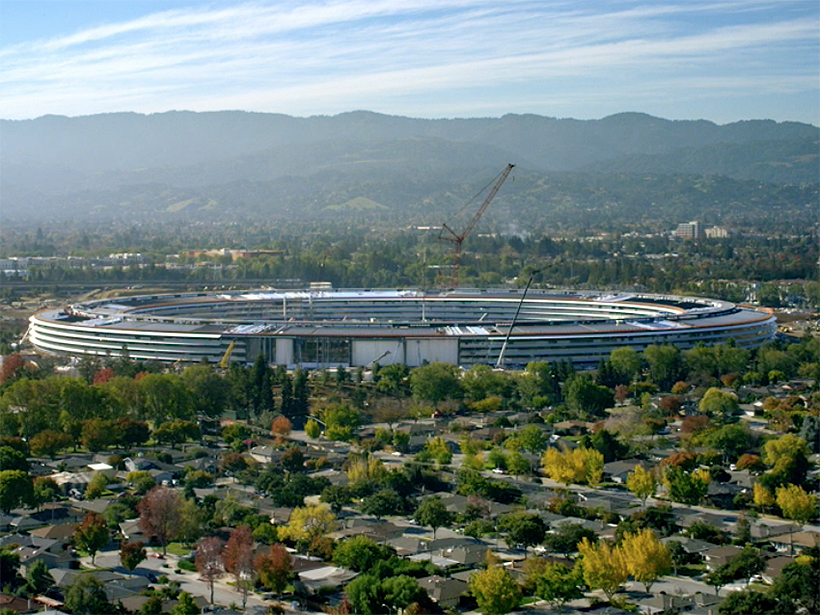Apple closes in on Apple Park opening

Apple employees last month began testing the company’s latest innovation: Apple Park, one of history’s most expensive corporate campuses and the leading example of the tech industry’s new-found love for splashy architecture.
The first of 12,000 Apple headquarters employees moved from several drab, stone buildings in Cupertino to space across town in the 2.8-million-square-foot circular building that resembles a spaceship. It features a seamless, curved-glass exterior and a theatre that architects said was designed to look like a MacBook Air. The estimated $5 billion project commanded years of attention from top Apple executives including Chief Design Officer Jony Ive, according to three of the more than 100 architects working on the campus.
Apple Park is the most lavish in a spate of glitzy new architectural projects by tech titans at a time when their businesses are booming and market valuations are soaring to new heights. Facebook and Alphabet have tapped top architects Frank Gehry and Bjarke Ingels for expansions, Amazon is building giant glass globes containing an indoor forest in Seattle, and business-software company Salesforce.com paid to put its name on a new, 61-story tower that will be the tallest building in San Francisco.
Commercial Insights: Subscribe to receive the latest news and updates
“This is what rich, wealthy and powerful individuals have done since the Pharaohs built the pyramids — you build a building that projects power to the world,” says Louise Mozingo, an urban-design professor at the University of California, Berkeley, who wrote a book on corporate campuses.
The trend marks a departure for the tech industry, which long eschewed the corporate palaces of banks and oil giants in favour of bland, low-slung office buildings like those on Apple’s existing campus. Even headquarters viewed locally as lavish — like former Sun Microsystems Inc.’s Silicon Valley campus — had relatively restrained designs.

Apple Park is being clad in the world’s largest curved glass windows. Picture: Apple.
“There’s always been this strain of practicality in Silicon Valley,” says Randy Howder, principal at the San Francisco-based architecture firm Gensler.
The new buildings are designed to project companies’ identities. Amazon, named after the rainforest, last week started planting trees in the glass spheres at the base of its new Seattle headquarters. Alphabet’s latest design for a new Google building, which it has been planning for a decade, calls for a public walkway that goes through a building topped by a soaring glass canopy, conveying openness.
Facebook’s Gehry-designed building, completed in 2015, features plywood that embodies the informality of Mark Zuckerberg, its hoodie-wearing chief executive.
Apple’s late CEO, Steve Jobs, helped initiate the boom. In 2009, he enlisted British architect Norman Foster, designer of the Hearst Tower in New York, to help bring a showcase corporate headquarters to Silicon Valley.

The Steve Jobs Theatre will be a star attraction at the new Apple Park.
Apple, which recently set a record by topping $800 billion in market capitalisation, says the new campus is designed to bring together disparate staff and foster collaboration to create new products.
Since unveiling plans in 2011, Apple’s design team has sought to influence everything from sprinklers to door handles. It commanded so much time of architects that Foster + Partners, which is based in London, eventually opened an office in the Bay Area to better manage requests, two architects said. They said Apple requested fully constructed mock-ups of details like stairways for review before construction, much as it builds prototypes of iPhones before ramping production.
Foster + Partners didn’t respond to requests for comment. Apple declined to comment.
The call for a theatre that resembled a MacBook Air suspended in space resulted in a structure featuring a heavy, carbon-fibre roof resting directly on glass walls. Architects and engineers had to conceal wiring and fire-protection tubes in the joints between each glass panel, the architects said. Guests will enter into the structure, named the Steve Jobs Theatre, and descend stairs to an underground auditorium with 1,000 seats.
Some observers see signs of hubris in the architectural bonanza. Mozingo, of UC Berkeley, believes Silicon Valley’s current move to trade flexible, bland workplaces for corporate statements could backfire, tying companies to a place and hindering their ability to relocate or innovate in a dynamic market.
“Once you invest that much cash, you become a different kind of company,” Mozingo says.
Corporate palaces of years past have sometimes presaged a bad turn in fortunes. Sun opened its new headquarters in 2000, around the time the dotcom implosion started devastating its business. The company was sold to Oracle in 2010 for $7.4 billion, a fraction of its former valuation. Facebook, which took over Sun’s campus in 2011, left Sun’s sign visible to remind employees of the risks of becoming comfortable with success.
– Wall Street Journal
This article originally appeared on www.theaustralian.com.au/property.







